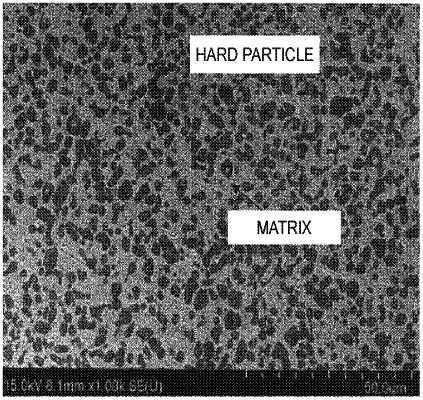| CPC C22C 38/56 (2013.01) [B22F 1/00 (2013.01); B22F 3/04 (2013.01); B22F 3/16 (2013.01); B22F 3/24 (2013.01); B22F 9/04 (2013.01); B26F 1/44 (2013.01); C22C 33/0285 (2013.01); C22C 33/0292 (2013.01); C22C 38/06 (2013.01); C22C 38/14 (2013.01); C22C 38/22 (2013.01); C22C 38/36 (2013.01); C22C 38/44 (2013.01); C22C 38/50 (2013.01); C22C 38/52 (2013.01); B22F 2003/248 (2013.01); B22F 2005/001 (2013.01); B22F 2201/20 (2013.01); B22F 2301/35 (2013.01); B22F 2302/10 (2013.01); B22F 2304/10 (2013.01); B22F 2998/10 (2013.01); B26F 2001/4436 (2013.01)] | 6 Claims |

|
2. An iron-based sintered alloy that is used in sliding components in pairs, the iron-based sintered alloy having a composition comprising, in terms of percent by mass, Ti: 18.4 to 24.6%, Mo: 2.8 to 6.6%, C: 4.7 to 7.0%, Cr: 7.5 to 10.0%, Ni: 4.5 to 6.5%, Co: 1.5 to 4.5%, Al: 0.6 to 1.0%, the balance being Fe and unavoidable impurities,
wherein the alloy has a structure in which hard particles are dispersed in a matrix, an area ratio of the hard particles is 38% to 41% and standard deviation of the area ratio of the hard particles is 2.5 to 3.5, and a maximum circle equivalent diameter of the hard particles is a predetermined value of 26.77 μm to 10 μm, and
the hard particles have a fine and relatively uniform shape and are homogenously dispersed over the whole matrix.
|